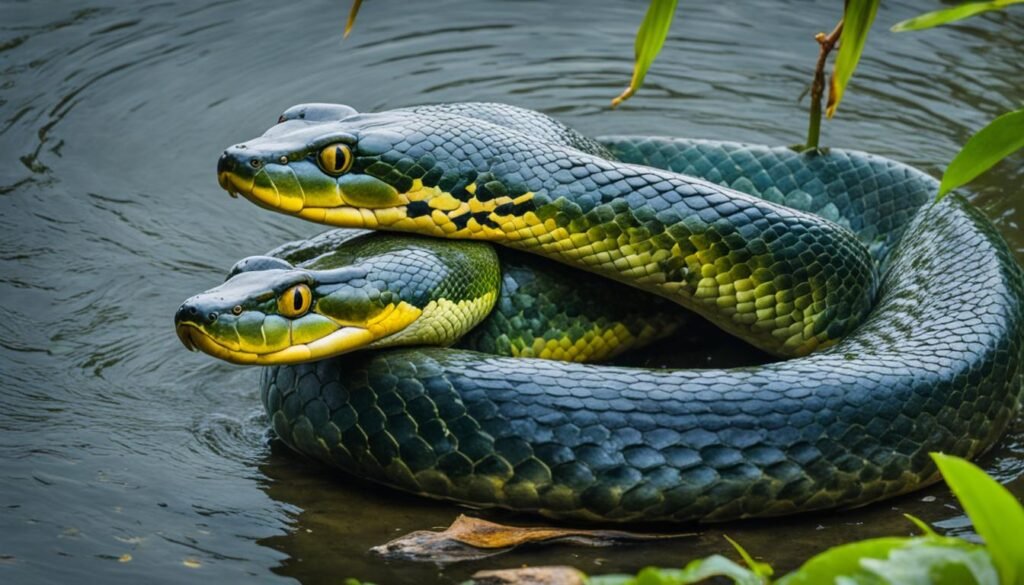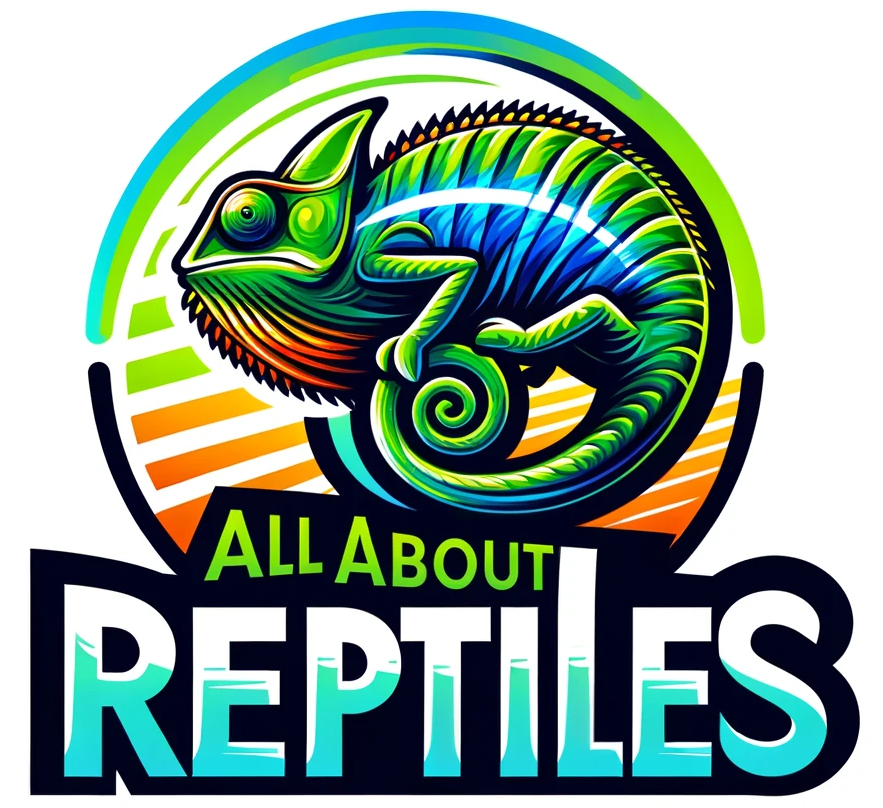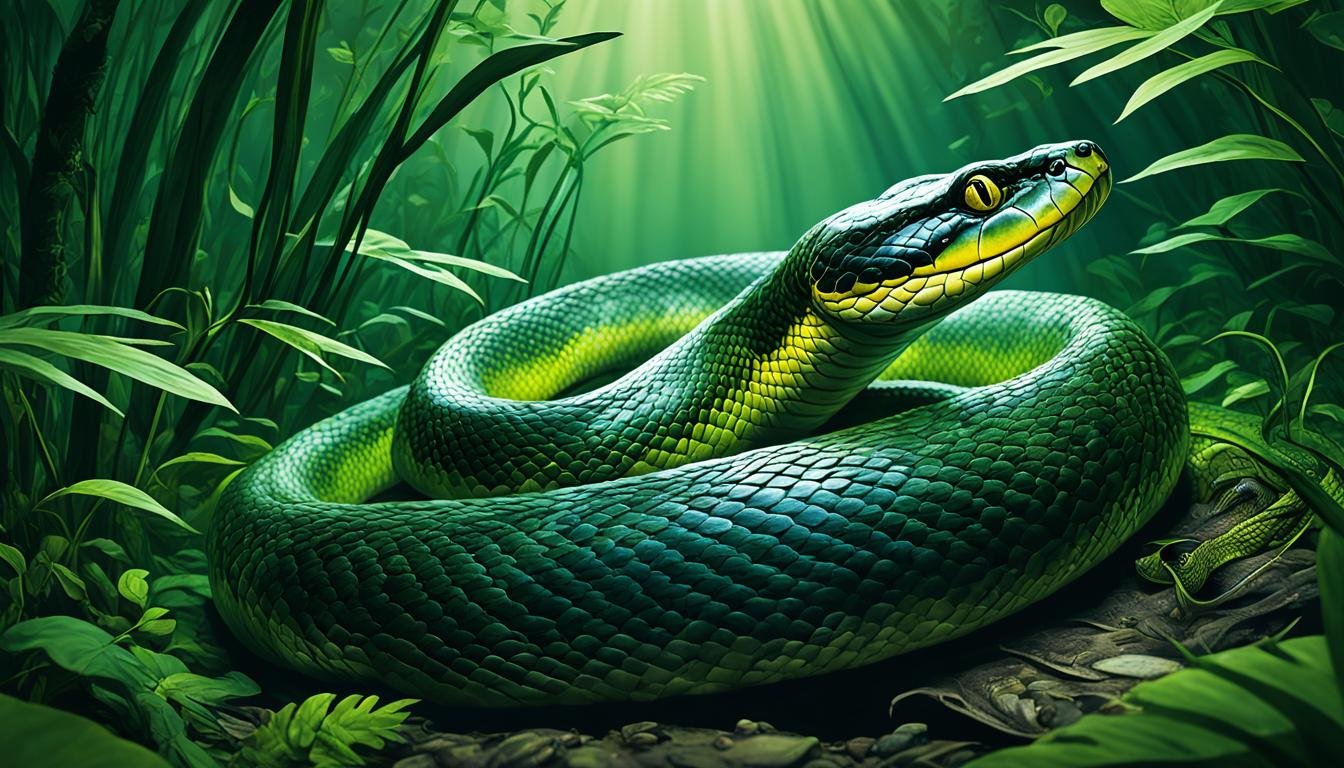Did you know that a green anaconda is capable of consuming a human? Although extremely rare, it showcases the immense size and power of these nonvenomous snakes. Green anacondas, belonging to the boa family, are formidable apex predators that are known for their incredible size, diverse diet, and unique habitat preferences.
Key Takeaways:
- Green anacondas are the largest snakes in the world, growing to lengths of over 29 feet and weighing more than 550 pounds.
- They have slow metabolisms and typically only need to eat once every few weeks.
- Green anacondas primarily inhabit the swamps, marshes, and slow-moving streams of the Amazon and Orinoco basins.
- These carnivorous snakes have a diverse diet that includes fish, birds, small mammals, deer, capybara, caimans, and large birds.
- Female green anacondas are significantly larger than males and can give birth to as many as 80 live young.
Size and Weight of Green Anacondas
When it comes to size, the green anaconda truly stands out as one of the largest snakes in the world. This impressive species can grow to lengths of over 29 feet, making it a true giant among snakes. But it doesn’t stop there – green anacondas can also weigh over 550 pounds, cementing their place as the heaviest snake species on the planet. With a girth of nearly 12 inches, these serpents are truly remarkable in their size and scope.
Females are particularly impressive, as they tend to be significantly larger than their male counterparts. This notable size difference between genders further adds to the allure and awe of the green anaconda’s incredible proportions.
To give you a visual representation of the green anaconda’s size, here is a table showcasing some of the world’s largest snakes:
| Snake Species | Length (feet) | Weight (pounds) |
|---|---|---|
| Green Anaconda | 29+ | 550+ |
| Reticulated Python | 22+ | 200+ |
| African Rock Python | 20+ | 200+ |
| Burmese Python | 18+ | 200+ |
As you can see, the green anaconda surpasses other well-known snake species in both size and weight, solidifying its status as the ultimate heavyweight in the snake kingdom.
Habitat of Green Anacondas
Green anacondas, also known as Eunectes murinus, are primarily found in the swamps, marshes, and slow-moving streams of the tropical rainforests in the Amazon and Orinoco basins. Their habitat is characterized by dense vegetation and abundant water sources. These massive snakes are well-adapted to their environment, with unique features that enable them to thrive in their anaconda habitat.
Aquatic Adaptations
Green anacondas are proficient swimmers, thanks to their cylindrical bodies, muscular tails, and partially webbed hind limbs. Their large size and streamlined shape allows them to navigate through the water with ease, making them formidable hunters in aquatic environments.
One of the distinctive characteristics of green anacondas is the placement of their eyes and nasal openings on the top of their heads. This adaptation allows them to remain submerged in the water while still being able to see and breathe. By keeping their body hidden, they can patiently wait for unsuspecting prey to come within striking distance.
Terrestrial Explorations
While green anacondas spend most of their time in the water, they are also capable of venturing onto land. This flexibility in habitat preference allows them to search for food, escape unfavorable conditions, or even move between bodies of water.
These massive snakes can navigate their way through the dense vegetation of the rainforest, using their muscular bodies and powerful coils to maneuver in treacherous terrain. They can even climb trees, using their strong muscles and recurved teeth to grip onto branches and explore higher ground.
The images above depict the green anaconda and its natural habitat, showcasing their extraordinary abilities to thrive in both aquatic and terrestrial environments.
Diet of Green Anacondas
When it comes to their diet, green anacondas display remarkable versatility. As carnivores, they utilize both their keen sight and exceptional sense of smell to hunt for prey. However, what sets them apart is their ability to detect the heat emitted by potential meals, giving them an edge in locating hidden targets.
Green anacondas are known to have a diverse taste in food, consuming a wide variety of animals. Their diet includes fish, birds, tapirs, wild pigs, capybaras, caimans, and even the occasional jaguar.
Unlike venomous snakes, anacondas are nonvenomous and rely on their incredibly strong bodies to overpower their prey. Once they capture their target, they wrap their muscular bodies around it, squeezing with immense force until the prey dies from either crushing or suffocation.
It is fascinating to note that green anacondas are capable of stretching their jaws to accommodate prey that is much larger than their own bodies. This astonishing capability allows them to devour meals that would be unimaginable for most other creatures.
After consuming a large meal, green anacondas can go weeks, or even months, without eating again. This ability to endure extended periods of fasting is an adaptation that helps them to survive in their often unpredictable and food-scarce environments.
Anaconda Diet: A snapshot
In summary, the diet of green anacondas is characterized by:
- A wide variety of prey, including fish, birds, tapirs, wild pigs, capybaras, caimans, and even jaguars.
- The use of sight, smell, and heat detection to locate and capture prey.
- Non-venomous and reliance on constriction to subdue and kill their victims.
- The ability to stretch their jaws to accommodate larger prey.
- Periods of fasting after consuming a substantial meal.
| Prey | Examples |
|---|---|
| Fish | Piranhas, catfish, freshwater eels |
| Birds | Herons, egrets, ducks, small- to medium-sized birds |
| Tapirs | South American tapirs |
| Wild Pigs | Collared peccaries, feral hogs |
| Capybaras | The largest rodent in the world |
| Caimans | Small to medium-sized crocodilians |
| Jaguars | South American jaguars |
Reproduction and Lifespan of Green Anacondas

When it comes to reproduction, female green anacondas have a fascinating method. Rather than laying eggs, they retain them and give birth to live young. In a single reproductive cycle, a female anaconda can produce as many as 80 tiny snakes. These baby snakes measure between 12 to 24 inches in length. What’s even more remarkable is that these newborns are already equipped with the ability to swim and hunt. They are born independent and ready to take on the challenges of survival.
As for their lifespan, green anacondas have different life expectancies depending on their environment. In the wild, their lifespan is typically around 10 years. However, in captivity, they can live much longer, with some individuals reaching up to 30 years.
Green anacondas have very interesting reproductive behaviors and exhibit different lifespan characteristics in different settings. These factors contribute to their overall adaptability and survival as a species.
Conservation Status of Green Anacondas
When it comes to the conservation status of green anacondas, they are currently not classified as endangered by the International Union for Conservation of Nature (IUCN). However, these magnificent creatures do face numerous threats, primarily habitat destruction and illegal hunting for their valuable skin.
Despite their native presence limited to South America, green anacondas have been spotted in certain Caribbean Islands and even in Florida. In these regions, they are considered an invasive species due to their large size and the potential impact they can have on the local wildlife.
The presence of green anacondas outside of their natural range can lead to disruptions in the delicate ecological balance, as they may outcompete or prey upon native species. As a result, efforts are being made to monitor and manage the populations of green anacondas in these non-native areas to prevent any adverse effects on the local ecosystems.
Furthermore, the conservation of green anacondas involves initiatives aimed at protecting their native habitats in South America. This includes the preservation of swamps, marshes, and streams where they thrive, as well as raising awareness about the importance of these ecosystems for the overall well-being of the anaconda populations and other species that depend on them.
Threats to Green Anacondas:
- Habitat destruction
- Illegal hunting for skin
- Potential impact as an invasive species
Efforts to conserve green anacondas involve habitat preservation, monitoring non-native populations, and raising awareness about their ecological importance. By protecting the habitats and addressing these threats, we can contribute to the long-term survival of these majestic creatures and the ecosystems they inhabit.
| Conservation Measures | Benefits |
|---|---|
| Preserving native habitats | Ensures suitable conditions for anaconda populations |
| Monitoring non-native populations | Prevents potential ecological disruptions |
| Regulating illegal hunting | Reduces pressure on anaconda populations |
| Increasing public awareness | Fosters appreciation and support for anaconda conservation |
Green Anaconda Distribution

The green anaconda, a magnificent species of snake, is primarily found in South America. Its distribution extends across the swamps, marshes, and streams of the Amazon and Orinoco basins, which provide the ideal habitat for its survival. These regions offer an abundance of prey and the perfect environment for the green anaconda to thrive.
However, this remarkable snake has also been observed in other areas beyond South America. It can be found in some Caribbean Islands where it has managed to adapt and establish its presence. One such example is Trinidad, where sightings of green anacondas have been documented. Additionally, these giant snakes have been spotted in the state of Florida, positioning themselves in yet another diverse environment.
The distribution of the green anaconda showcases its ability to adapt and explore new territories. While it is native to South America, the presence of the species in other regions highlights the species’ resilience and adaptability.
| Green Anaconda Distribution | |
|---|---|
| Native Range | South America (Amazon and Orinoco basins) |
| Additional Range | Some Caribbean Islands, Florida |
Resources for Learning More about Green Anacondas
If you’re interested in diving deeper into the fascinating world of green anacondas, there are several reputable resources you can explore. These sources offer comprehensive information on the characteristics, behavior, and habitats of these incredible snakes, allowing you to learn more about their unique features and importance in the ecosystem.
- Vancouver Aquarium: The Vancouver Aquarium website provides in-depth articles and educational resources that cover various aspects of green anacondas. From their size and diet to their conservation status, you’ll find a wealth of knowledge to satisfy your curiosity.
- Sea World: Sea World’s website offers a dedicated section on green anacondas, where you can discover interesting facts, videos, and interactive content. Explore their habitat, learn about their incredible abilities, and gain insights into their conservation efforts.
- National Geographic: As a trusted source for wildlife information, National Geographic provides comprehensive articles, photographs, and videos about green anacondas. Get a closer look at these magnificent creatures and gain a deeper understanding of their behavior and natural habitats.
- National Zoo: The National Zoo’s website offers valuable resources on green anacondas, including detailed information on their size, diet, reproduction, and more. Find out what it takes to care for these impressive snakes in a zoo setting and gain new perspectives on their conservation status.
By exploring these resources, you’ll have a wealth of knowledge at your fingertips to uncover the secrets of green anacondas. Delve into their world and discover the wonders of these incredible reptiles.
Tips for Further Exploration:
- Take your time to explore each website thoroughly, ensuring you don’t miss any valuable information.
- Bookmark the websites for future reference to easily access the resources whenever you want to learn more about green anacondas.
- Subscribe to newsletters or follow the social media accounts of these organizations to stay updated on the latest research and news about green anacondas.
Conclusion
Green anacondas are truly remarkable creatures, characterized by their impressive size, diverse diet, and distinct habitat preferences. As the heaviest snake species, they can reach astonishing lengths and possess the ability to consume prey much larger than themselves. Found primarily in the swamps and marshes of South America, green anacondas have also been observed in other regions.
Although green anacondas are not currently considered endangered, they face significant threats from habitat destruction and illegal hunting, emphasizing the importance of protecting their natural environments. By learning more about these incredible snakes and their role in the ecosystem, we can gain a deeper understanding of their significance and work towards their conservation.
From their capability to detach their jaws for swallowing large prey to their exceptional swimming abilities and diverse diet, green anacondas exemplify the fascinating world of reptiles. Being aware of their unique characteristics and their place in the natural world allows us to appreciate the marvels of nature and the incredible biodiversity that exists.
FAQ
What is a green anaconda?
How big can green anacondas grow?
What is the diet of green anacondas?
Where do green anacondas live?
How do green anacondas hunt?
How do green anacondas reproduce?
What is the lifespan of green anacondas?
Are green anacondas endangered?
Where can I find more information about green anacondas?
What are the characteristics of green anacondas?
References
| Organization Name | URL |
| International Reptile Conservation Foundation (IRCF) | https://www.ircf.org/ |
| Herpetological Conservation International | https://herpconservation.com/index.html |
| Society for the Study of Amphibians and Reptiles (SSAR) | https://ssarherps.org/about-ssar/ |


2 thoughts on “Green Anaconda Facts: Size, Diet & Habitat”